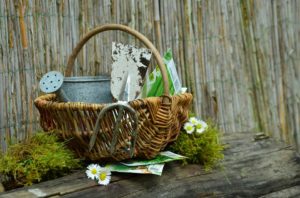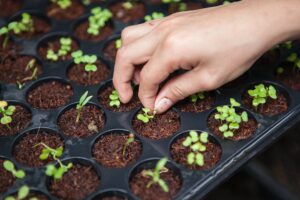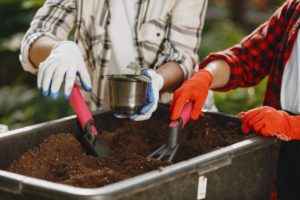Choosing the right kind of soil for your container garden is arguably the most important step in growing vegetables for you and your family. Healthy soil is critical if you want to grow healthy plants and produce. You may be tempted to cut corners, but don’t skip this step or you’ll pay for it in the long run with unhealthy plants and a less than desirable harvest.
Topsoil or Potting Soil for Your Container?
If you are considering using soil from your yard or flower beds to fill your containers, think again. Topsoil is too compacted for the plant’s tender roots to penetrate. What’s more, there’s a good chance the soil contains undesirable insects, insect eggs or larva, just waiting to devour your hard work. New topsoil is not a good option either as it will still be too heavy for the plant’s roots to pass through easily.
Another reason not to use topsoil or soil from your beds is that grass and weed seeds, viruses, bacteria, and other pathogens harmful to tender plants are more than likely present in the soil. It’s best to start from scratch and use organic potting 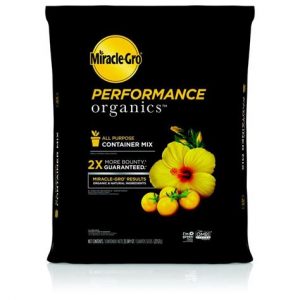 mix. This way, you can be sure it will be free of pesticides, synthetic fertilizers, and other chemicals that can be harmful to human consumption as well as pathogens and insects. In addition, organic potting mix will contain nutrients that come from natural sources that will benefit the plant and, therefore, you. (Although the terms are sometimes used interchangeably, potting soil and potting mix are not the same. Learn about the differences in this helpful article.)
mix. This way, you can be sure it will be free of pesticides, synthetic fertilizers, and other chemicals that can be harmful to human consumption as well as pathogens and insects. In addition, organic potting mix will contain nutrients that come from natural sources that will benefit the plant and, therefore, you. (Although the terms are sometimes used interchangeably, potting soil and potting mix are not the same. Learn about the differences in this helpful article.)
Some of the links in this article are affiliate links. If you buy a product via my affiliate link, I will receive a very small commission at no additional cost to you, and it will help me maintain this website. Rest assured that I only recommend products I actually like!
How to Choose the Right Mix
When choosing a mix, look for organic matter such as compost, manure, worm castings, and even bat guano to be listed in the ingredients. In addition, the mix should contain minerals such as vermiculite or perlite, which will improve soil aeration and enhance moisture and nutrient retention. Packaged mixes are readily available at the big box stores as well as your local nursery. I live in a smaller city so the most affordable organic potting soil that is readily available in my area is Miracle-Gro’s Performance Organics. It contains all the key ingredients, and it is reasonably priced, especially considering it’s organic. I have been pleased with the results. But there are other brands, so be sure to find out what is available in your area.
If you’re going to be filling raised beds or numerous large containers, it may be more cost-effective to buy organic soil in bulk. An online search can help you find companies in your area that sell to the public.
Blend Your Own
Another cost-effective way to obtain an organic mix for numerous containers is by blending it yourself. There are many formulas available that use the same basic principles, while the specific ingredients may vary.
Mel Bartholomew of the Square Foot Gardener fame recommends the following mix: 1/3 blended compost (i.e., compost consisting of more than one ingredient), 1/3 peat moss, and 1/3 coarse vermiculite. Bartholomew writes, “Mix equal parts of each, measured by volume, not by weight.”[1] The compost will deliver the nutrients. The peat moss stores the nutrients and then releases them slowly, and also helps to aerate the mixture and retain water. Similarly, the vermiculite will aerate the soil and aid in nutrient and water retention.
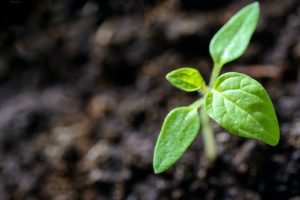
Garden Guides suggests a blend of equal parts peat moss, compost and builder’s sand which will improve overall drainage.[2] While Home and Garden for Dummies advises a slightly more involved mix of ½ cubic yard of sphagnum peat moss, ½ cubic yard of vermiculite, 10 pounds of bone meal, 5 pounds of dolomite limestone and 5 pounds of blood meal.[3] Adjust the portions if this creates more soil than you need, just make sure to keep the proportions the same.
Recycle Used Organic Potting Soil
Organic soil mix can account for a large portion of your gardening budget, so be sure to reuse your container mix each season. Replenish the nutrients by adding organic soil fertilizers/conditioners like Dr. Earth’s, which contains nutrients, probiotics, soil microbes, and mycorrhizae. Be sure to follow package directions.
Alternatively, if you’ve reused the container mix for more than a few growing seasons you can remove half of it and replenish it with new organic mix. This will give you a mixture of half used and half new potting mix. You may then want to add additional nitrogen (like blood meal) or phosphorous (like bone meal) depending on what you’re going to plant in it. You can save the used mix that you removed to rejuvenate at a later date or add it to the compost pile for bulk.
If the used soil came from a container that housed a plant stricken with Verticillium wilt, Fusarim wilt, or powdery mildew, or if it was infested with insects, it may be harboring pathogens or possibly insect eggs. If this is the case, you should refrain from reusing it. Some will advise that it is safe to reuse as long as you are not replanting the same crop or a member from the same crop family in the container. Others may recommend soil solarization to help eliminate potential problems. You’ll have to decide which is best for you and your garden.
Soil is the most important building block of any garden so be sure to do it right the first time or it could cost you more time, money and grief in the long run.
Note: If you found this article to be helpful, please share it with someone you think might be interested in it as well. Thank you!
[1] Mel Bartholomew, All New Square Foot Gardening (Brentwood, TN: Cool Spring Press, 2006), p. 89.
[2] Kaye Lynne Booth, “The Best Potting Soils for a Vegetable Garden,” Garden Guides, 11-29-10, accessed 6-18-20. https://www.gardenguides.com/list_7575714_potting-soils-vegetable-garden.html
[3] Bill Marken and Suzanne DeJohn, “How to Mix Your Own Soil for Container Planting,” Home and Garden for Dummies, accessed 6-18-20, https://www.dummies.com/home-garden/gardening/container-gardening/how-to-mix-your-own-soil-for-container-plantings/

